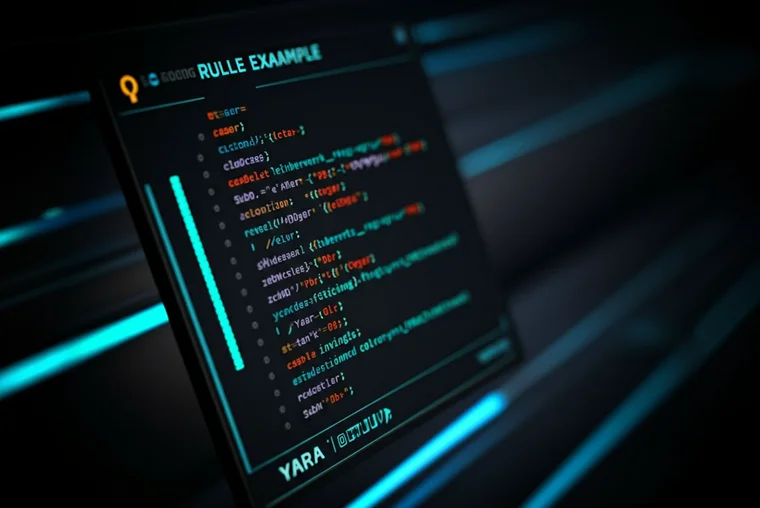Cybersecurity is no longer an option in today's digital landscape. Every business, regardless of size, needs a robust defense against malware threats that can spy on, steal from, or outright destroy systems. Enter YARA rules, the unsung hero of malware detection. If you're looking to step up how you identify and neutralize threats, YARA rules offer a flexible, highly effective solution.
This guide covers everything you need to know about YARA rules—from what they are, and why they matter, to how to create and deploy them in your cybersecurity arsenal.
What Are YARA Rules?
YARA, an acronym for Yet Another Recursive Acronym, is a powerful open-source tool primarily used for identifying and classifying malware. Think of YARA rules as precise blueprints that cybersecurity pros write to sniff out malicious software. They allow analysts to describe malware or suspicious files using:
-
Text strings (e.g., known code snippets or artifacts)
-
Hex patterns (specific byte sequences in files)
-
Regular expressions
-
Logical conditions (e.g., if a file contains at least two out of three patterns)
These rules work by:
-
Scanning files for unique patterns or strings commonly associated with malware.
-
Using metadata and logical conditions to form detailed detection criteria.
-
Flagging suspicious files or network activities before they cause damage.
Unlike standard antivirus solutions, YARA rules aren't limited to a set database of signatures. Instead, they provide customizable, real-time detection tailored to evolving threats.
Why Should You Care About YARA Rules?
The stakes are high. Cyberattacks, particularly ransomware, are increasingly sophisticated. YARA stands out among detection tools for its precision and adaptability in this hostile environment. Here's why YARA is a game-changer for businesses:
1. Pinpoint Accuracy
YARA rules dig deep into a file's anatomy, offering detailed pattern-matching to identify even the most obscure malware variants.
2. Real-Time Defense
YARA integrates seamlessly with platforms like Security Information and Event Management (SIEM) systems, enabling instant threat detection and response.
3. Constantly Evolving
Malware evolves daily. Thankfully, YARA’s open-source nature means you can write or tweak rules to counter constantly changing threats.
How to Write Effective YARA Rules
If you're excited to explore the world of YARA rules, here's a step-by-step guide to get started:
Step 1. Define Your Target
Identify and analyze the malware strain and its behaviors or patterns you wish to detect. Is it ransomware? A specific trojan? Clearly outlining your goals will help in creating focused and effective rules.
Step 2. Write Your Rule
YARA rules use a syntax that's easy to understand, even for beginners. Every rule includes the following components:
Meta: Metadata like rule author, description, and date for tracking purposes.
Strings: Unique characteristics of the malware (e.g., pieces of code or known malicious text).
Condition: Logical statements that define when a rule will trigger based on the strings section.
Example Rule:
```
rule Detect_Malware {
meta:
author = "Your Team"
description = "Detects unique malware patterns"
strings:
$pattern1 = "malicious_code_snippet"
condition:
$pattern1
}
```
Step 3. Test Your Rule
Before deployment, validate how your rule performs against real-world samples. YARA offers test environments so you can tweak for precision and avoid false positives.
Step 4. Deploy and Monitor
Once satisfied, integrate the rules into your detection software or SIEM system. Monitor results over time, refine your rules, and keep them updated as malware evolves.
Top Use Cases for YARA Rules
YARA isn’t just about scanning files. Its capabilities extend into various cybersecurity functions that can give your organization a solid defensive advantage.
Routine Malware Detection
Scan incoming files or live network traffic to spot malware before it infiltrates your systems.
Threat Intelligence
Collaborate globally by sharing and importing Indicators of Compromise (IoCs) to improve threat awareness.
Ransomware Defense
Identify ransomware-specific markers (e.g., unique encryption patterns, ransom notes), helping you act fast to isolate threats and safeguard backups.
Beyond Basics: Advanced YARA Practices
Here are some advanced techniques to maximize YARA's potential:
-
Create Templates: Use consistent structures for your rules to streamline future development and maintenance.
-
Leverage Community Contributions: Tap into popular repositories like "Awesome YARA" for pre-made rules that can save time while strengthening your defenses.
-
Write Granular Rules: Avoid overly broad rules to reduce false positives and maintain precise detection.
Automate YARA for Enhanced Efficiency
Integrating automation with YARA boosts response speed and accuracy. Tools like Python scripts can help you:
-
Trigger alerts for detected threats via email, Slack, or other platforms.
-
Assign priority levels to flagged threats so your team knows what needs immediate action.
Integrating YARA Into Your Security Ecosystem
One of YARA's greatest strengths is its ability to integrate with existing security platforms. Many enterprise tools, from endpoint detection solutions to threat intelligence platforms, support YARA natively.
With YARA running in the background, automated scans can monitor:
-
Email attachments for phishing schemes.
-
Web content for sneaky exploits or malware downloads.
-
File uploads to ensure no malicious surprises.
Building the Future of Cybersecurity with YARA
Cybersecurity is an ongoing race between attackers and defenders. With YARA, businesses gain a significant edge in this contest. This tool not only enables organizations to detect today’s threats but also adapt to tomorrow’s challenges.
Implementing YARA isn’t just about bolstering defense. It’s about elevating how your organization approaches threat detection, building resilience, and staying ahead of cybercriminals.


Provide an Impactful SAT Experience
Don’t just check a compliance box. Elevate your workplace’s security culture while giving your employees an enjoyable experience.









